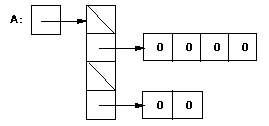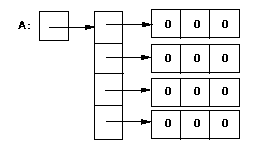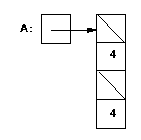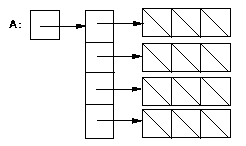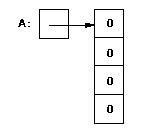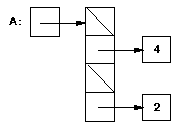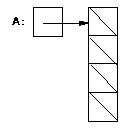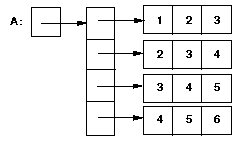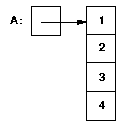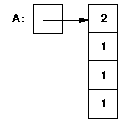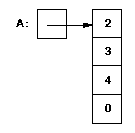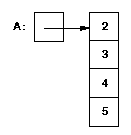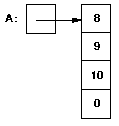JAVA CLASSES
Contents
- Fields, Methods, and Access Levels
- Simple Example Java Class
- Static vs Non-Static Fields and Methods
- Final Fields and Methods
- Test Yourself #1
- Some Useful Built-in Classes
- Test Yourself #2
- Answers to Self-Study Questions
Fields, Methods, and Access Levels
- private: accessible only in this class
- (package): accessible only in this package
- protected: accessible only in this package and in all subclasses of this class
- public: accessible everywhere this class is available
- (package): class objects can only be declared and manipulated by code in this package
- public: class objects can be declared and manipulated by code in any package
Simple Example Class
Here's a (partial) example class; a List is an ordered collection of items of any type:
class List { // fields private Object [] items; // store the items in an array private int numItems; // the current # of items in the list // methods // constructor function public List() { items = new Object[10]; numItems = 0; } // AddToEnd: add a given item to the end of the list public void AddToEnd(Object ob) { ... } } Notes- Object: Object-oriented programming involves inheritance. In Java, all classes (built-in or user-defined) are (implicitly) subclasses of Object. Using an array of Object in the List class allows any kind of Object (an instance of any class) to be stored in the list. However, primitive types (int, char, etc) cannot be stored in the list.
- Constructor function: As in C++, constructor functions in Java:
- Are used to initialize each instance of a class.
- Have no return type (not even void).
- Can be overloaded; you can have multiple constructor functions, each with different numbers and/or types of arguments.
It is often useful to have one constructor call another (for example, a constructor with no arguments might call a constructor with one argument, passing a default value). The call must be the first statement in the constructor. It is performed using this as if it were the name of the method. For example:
- this( 10 );
- Initialization of fields: If you don't initialize a field (i.e., either you don't write any constructor function, or your constructor function just doesn't assign a value to that field), the field will be given a default value, depending on its type. The values are the same as those used to initialize newly created arrays (see the "Java vs C++" notes).
- Access Control: Note that the access control must be specified for every field and every method; there is no grouping as in C++. For example, given these declarations:
- public
- int x;
- int y;
only x is public; y gets the default, package access.
Static Fields and Methods
static int numLists = 0;And the following statement to the List constructor:
numLists++;Now every time a new List object is created, the numLists variable is incremented; so it maintains a count of the total number of Lists created during program execution. Every instance of a List could access this variable (could both read it and write into it), and they would all be accessing the same variable, not their own individual copies.
A method should be made static when it does not access any of the non-static fields of the class, and does not call any non-static methods. (In fact, a static method cannot access non-static fields or call non-static methods.) Methods that would be "free" functions in C++ (i.e., not members of any class) should be static methods in Java. Also, methods that are logically associated with a particular class, but that only manipulate the class's static fields should be static. For example, if we wanted a function to print the current value of the numLists field defined above, that function should be defined as a static method of the List class.
A public static field or method can be accessed from outside the class using either the usual notation:
class-object.field-or-method-nameor using the class name instead of the name of the class object:
class-name.field-or-method-nameFor example, if the numLists field is public, and there is a variable L of type List, the numLists field can be accessed using either L.numLists or List.numLists. Similarly, if the List class includes a public static method PrintNumLists, then the method can be called using either L.PrintNumLists() or List.PrintNumLists().
The preferred way to access a static field or a static method is using the class name (not using a class object). This is because it makes it clear that the field or method being accessed is static.
Final Fields and Methods
private static final int INITIAL_SIZE = 10;The assignment statement in the constructor function would change to:
items = new Object[INITIAL_SIZE];
Consider the program defined below.
class Test { static int x; int k; // constructor with 2 args public Test( int n, int m ) { x = n; k = m; } public static void main(String[] args) { Test t1 = new Test(10, 20); Test t2 = new Test(30, 40); System.out.print(t1.x + " "); System.out.print(t1.k + " "); System.out.print(t2.x + " "); System.out.println(t2.k); } } Question 1: Which of the following is true?A. This program must be in a file called Test.java. Compiling will create one new file called Test.class. B. This program can be in any .java file. Compiling will create one new file called Test.class. C. This program must be in a file called Test.java. Compiling will create two new files called Test.class and main.class. D. This program can be in any .java file. Compiling will create two new files called Test.class and main.class.
Question 2: Which of the following correctly describes what happens when the program is compiled and run?
A. There will be a compile-time error because there is no constructor with no arguments. B. There will be a run-time error because there is no constructor with no arguments. C. There will be no errors; the output will be: 10 20 30 40 D. There will be no errors; the output will be: 30 20 30 40 E. There will be no errors; the output will be: 30 40 30 40
Some Useful Built-in Classes
Note: These classes are not really part of the language; they are provided in the package java.lang. You can get more information on-line via the Java Packages page.
String
- to create a String:
String S1 = "hello", // initialize from a string literal S2 = new String("bye"), // use new and the String constructor S3 = new String(S1); // use new and a different constructorThere are lots more String constructors, see the documentation. - to concatenate:
String S1 = "hello" + "bye", S2 = S1 + "!", S3 = S1 + 10; // the int 10 will be converted to a String, // because the other operand of + is a // String
Note: in all of the examples above, a new string is created and the variable (S1, S2, or S3) is set to point to that new string. For example, the expression S1 + "!" does not change what S1 points to, it creates a new string that contains "hellobye!". - Other methods of the String class:
int length() // Note: different from arrays, which just use // length without parens char charAt(int k) // return the kth character in the string, starting // with 0 // runtime error if k <>= length() int compareTo(String S) // compare this string with string S // return: // 0 if they are the same // a positive int if this string is greater // a negative int if this string is less boolean equals(Object S) // return true if S is a non-null String that // contains the same characters as this String String substring( -- several forms -- ) // see documentation toLowerCase() toUpperCase() Lots more -- see documentation!
Object
- this is the base class for all Java classes.
- methods:
String toString() // return a string representation of this object // note: for user-defined classes, the default value // is not very useful so you should define your // own toString method boolean equals(Object ob) // return true iff this object is the same as // ob // note: uses pointer equality for user- // defined classes; you may want to // redefine this method More -- see documentation!
Boolean, Integer, Double, etc
- One such class for each primitive type.
- Use these "wrapper" classes when you need an Object. For example, think about the List class. Suppose you try this:
List L = new List(); L.AddToEnd( 10 );
You get a compile-time error saying that type int cannot be converted to type Object. That's because the AddToEnd method takes an Object as its parameter, and a primitive type like int is not an Object. You can fix this using:L.AddToEnd( new Integer( 10 ) );
This creates a new Integer object, with the value 10, and passes that object to the AddToEnd method. Note that if you want to retrieve a particular kind of object from a list, you must use a cast. For example, assume that the List class also includes methods to allow a user of the class to iterate through the items in a list; i.e., we think of every list as having a "current pointer", and methods are provided to get the current item, and to move the current pointer:public void firstElement() // set the current pointer to point to the // first item on the list public Object NextElement() // return the item pointed to by the current // pointer; also advance the current pointer public boolean hasMoreElements() // true iff the current pointer has // not fallen off the end of the list
If you do this:L.AddToEnd( new Integer( 10 ) ); L.firstElement(); Integer K = L.nextElement();
you'll get a compile-time error saying that you must use an explicit cast to convert an Object to an Integer. That's because the return type of nextElement is Object, and you're trying to assign that into variable K, which is an Integer. Here's what you need to do:Integer K = (Integer)L.nextElement();
- You can get back a (primitive) value from these wrapper classes using the method xxxValue, where xxx is the primitive type. For example:
Integer K = new Integer( 10 ); int x = K.intValue(); Boolean B = new Boolean( true ); boolean b = B.boolValue();
- These classes also provide some useful constants: Integer.MAX_VALUE (the largest int that can be represented), Integer.MIN_VALUE, Double.MAX_VALUE, Double.MIN_VALUE, Double.POSITIVE_INFINITY, etc.
Question 1: Consider the following program.
class Test { static void Swap(Integer j, Integer k) { int tmp = k.intValue(); k = new Integer(j.intValue()); j = new Integer(tmp); } public static void main(String[] args) { Integer n = new Integer(5), m = new Integer(6); Swap(n, m); System.out.println("n = " + n + "; m = " + m); } } The person who wrote this program expected the output to be: n = 6; m = 5. However, the actual output is: n = 5; m = 6. Explain why.Question 2: Consider the following function. This function was intended to create and return a string that is the reverse of its parameter. (For example, if parameter S = "hello", the function should return "olleh".) However, there are several problems with the function as written.
static String Reverse(String S) { String newS = ""; char c = S[0]; while (c) { newS = c + newS; c++; } return newS; } First, identify each problem (write the bad code and give a brief explanation of why it is incorrect). Then give a new, correct version of function Reverse.Solutions to Self-Study Questions
Test Yourself #1
Question 1: B. This program can be in any .java file. Compiling will create one new file called Test.class. (It does not have to be in Test.java, because class Test is not public. No file "main.class" is created, because main is a method, not a class.) Question 2: D. There will be no errors; the output will be: 30 20 30 40 (There is no need for a constructor with no arguments because there are no uses of "new Test" with no arguments.)
Test Yourself #2
Question 1: Why does this program produce the output n = 5; m = 6? In Java, all parameters are passed by value, so changes to the parameters themselves in the function do not affect the values that were passed. The Swap function changes its parameters, j and k, making them point to new Integers, but that has no effect on the values that were passed (variables n and m). Question 2: static String Reverse(String S) { String newS = ""; char c = S[0]; // can't index Strings in Java while (c) { // not a boolean loop condition // (but this would work in C/C++) newS = c + newS; c++; // this doesn't help fetch the next char in S // (increments ascii value of c) } return newS; } Correct version: static String Reverse(String S) { String newS = ""; for (int i=0; i